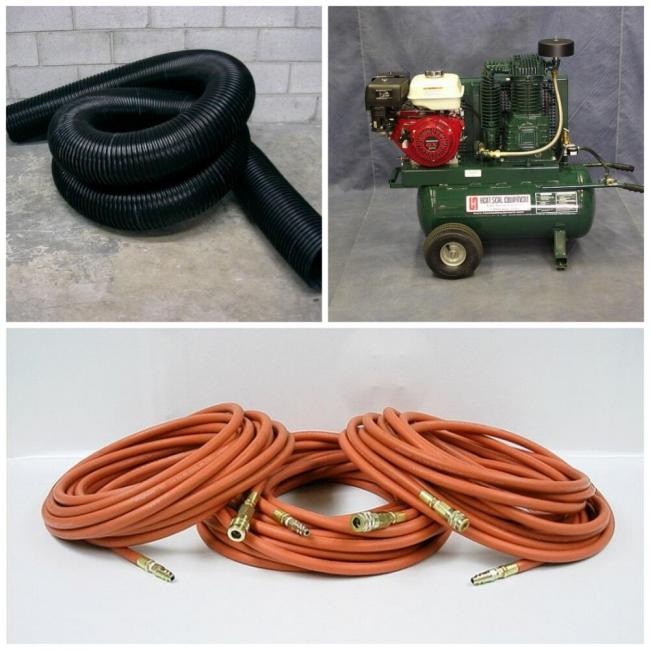Air Duct Cleaning Tools: 3 Small Upgrades To Supercharge Efficiency

For HVAC contractors, output per hour is the strongest measure of jobsite performance. The goal is always to figure out the maximum duct length that can be cleaned in the least amount of time possible with minimum disruption and lower labor fatigue.
If, like most, you think the answer lies in getting bigger, higher-capacity machines to achieve that, you might be mistaken. You do not need to change your current feature-rich vacuum and swap it for a bigger one. What you need to do is focus on the accessories you use.
You might not believe this, but on-site performance is greatly compromised when you do not use the right accessories to support your main ones. Fortunately, a few small and inexpensive upgrades can put you back on the track of efficiency.
In this blog, Heat Seal Equipment Ltd., a reputed supplier of air duct cleaning tools in Ontario, will discuss the three essential accessory upgrades your cleaning kit needs.
Which Accessories Are A Must-Have For Air Duct Cleaning?
The world of air duct cleaning tools is vast. Littered with different types of accessories from various brands, choosing the ones you need among them can feel like a Herculean task. Do not worry as our list below covers exactly the add-ons you need to boost efficiency:
Suction hoses and related accessories
Narrow suction hoses or those riddled with kinks can slow airflow down. The same happens if you use hoses that are too short or too rough on the inside. The major problem with low airflow is that it reduces the suction power of your vacuum, thus leading to a lower removal speed.
Getting the right hoses can fix that. Investing in a high-quality suction hose system ensures less interior turbulence coupled with reduced static pressure drop. You can expect fewer clogs and obstructions, combined with smoother transitions between attachments.
While this may seem like a tiny change, its impact is great. Restricted hoses can increase recovery time by several minutes per register, which can add up to hours on large-scale projects.
Auxiliary tank
If you have not added an auxiliary tank to your setup already, it is time you did. A good duct cleaning air compressor is capable of powering your pneumatic tools, whips, and agitation systems like nothing else. However, bear in mind that the tank you get should provide a high volume of usable air at a stable PSI to ensure it works as intended.
That said, the benefits of using an auxiliary compressor are many. For example, since they increase usable buffer volume, you do not have to cycle through them frequently. They also help in stabilizing tool performance, giving rise to more consistent whipping action inside ducts. Plus, the smoother delivery of agitation bursts ensures you get the job done on time – all without needing to invest in an expensive and larger compressor.
Airline fittings and quick disconnect systems
Time wasted on switching tools during a duct cleaning job can severely hamper its efficiency. Especially because it reduces the amount of time you can spend actively cleaning ducts. To speed up the transition, you need to upgrade to premium airline fittings and high-quality quick disconnect systems.
Adept at preventing micro delays, these enable faster tool swaps with fewer leaks. As a result, you get more consistent PSI at the head of the tools you use, which makes cleaning a less frustrating and more productive experience. Moreover, you get more usable minutes per hour, so it is a complete win-win.
Conclusion
The bottom line is that the air duct cleaning tools and accessories you invest in should offer you maximum value. When your operations are efficient from the get-go, you end up making room for more jobs, which can boost your business’s profitability without sacrificing its reputation.
Heat Seal Equipment Ltd. manufactures and supplies Canadian-made duct cleaning tools and accessories that are known to increase the productivity of Ontario-based HVAC contractors. Contact us to upgrade your toolkit with equipment that guarantees efficiency-boosting results each time.
FAQs
How often should duct cleaning hoses be replaced?
Though the frequency of swapping your hoses is dependent on their condition, most experts recommend replacing them annually.
Can quick disconnect fittings reduce pressure?
Yes. High-quality systems are designed to minimize pressure drops, thus delivering consistent performance. Whereas cheap fittings restrict flow entirely.
Can auxiliary tanks be used without a duct cleaning air compressor?
No. They only work with a compatible air compressor. So be sure to check if the PSI, volume, and fittings of both match.





